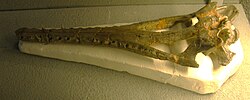Thoracosaurus
| Thoracosaurus Temporal range: Late Cretaceous - Early Paleocene,
| |
|---|---|

| |
| Thoracosaurus isorhynchus skull | |
| Scientific classification | |
| Kingdom: | Animalia |
| Phylum: | Chordata |
| Class: | Reptilia |
| Order: | Crocodilia |
| Superfamily: | Gavialoidea |
| Genus: | †Thoracosaurus Leidy, 1852 |
| Species | |
Thoracosaurus is an extinct genus of eusuchian crocodylomorph which existed during the Late Cretaceous and Early Paleocene. The animal had traditionally been thought to be related to the modern false gharial, largely because the nasal bones contact the premaxillae. Phylogenetic work starting in the 1990s instead supported affinities within Gavialoidea exclusive of such forms,[2] although a 2018 tip dating study simultaneously using morphological, molecular (DNA sequencing), and stratigraphic (fossil age) data suggests that it might have been a non-crocodylian eusuchian.[3] The genus contains the species Thoracosaurus neocesariensis in North America[4] and what is either Thoracosaurus isorhynchus or T. macrorhynchus; a recent review[5] argues that T. macrorhynchus is a junior synonym of T. isorhynchus, but it is unclear whether the type of T. isorhynchus allows differentiation of European and North American Thoracosaurus; if not, then T. isorhynchus would be a nomen dubium. A number of species have been referred to this genus, but most are dubious.[2]
Thoracosaurus scanicus was a fairly large animal, with a length of more than 4.4 m (14.4 ft) and a 55 cm skull.[6]

Thoracosaurus sp. teeth at the Geological Museum, Copenhagen
References[]
- ^ Rio, Jonathan P.; Mannion, Philip D. (6 September 2021). "Phylogenetic analysis of a new morphological dataset elucidates the evolutionary history of Crocodylia and resolves the long-standing gharial problem". PeerJ. 9: e12094. doi:10.7717/peerj.12094. PMC 8428266. PMID 34567843.
- ^ a b Brochu, C. A. (2006). "Osteology and phylogenetic significance of Eosuchus minor (Marsh, 1870) new combination, a longirostrine crocodylian from the Late Paleocene of North America". Journal of Paleontology. 80 (1): 162–186. doi:10.1666/0022-3360(2006)080[0162:OAPSOE]2.0.CO;2.
- ^ Michael S. Y. Lee; Adam M. Yates (2018). "Tip-dating and homoplasy: reconciling the shallow molecular divergences of modern gharials with their long fossil record". Proceedings of the Royal Society B: Biological Sciences. 285 (1881): 20181071. doi:10.1098/rspb.2018.1071. PMC 6030529. PMID 30051855.
- ^ Page 125; A study of fossil vertebrate types in the Academy of Natural Sciences of Philadelphia: taxonomic, systematic, and historical perspectives Issue 16 of Special Publication Series, Academy of Natural Sciences (Philadelphia, Pa.) By Earle E. Spamer, Edward Daeschler, L. Gay Vostreys-Shapiro. Academy of Natural Sciences, 1995 ISBN 0-910006-51-2 ISBN 978-0-910006-51-4
- ^ Brignon, A. (2017). "The collecting of fossil vertebrates in Mont-Aimé (Marne, France) by the Baron de Ponsort (1792–1854)". Bulletin d'Information des Géologues du Bassin de Paris. 54 (3): 20–44.
- ^ "Archived copy". Archived from the original on 2012-02-08. Retrieved 2012-02-08.
{{cite web}}: CS1 maint: archived copy as title (link)
- Neosuchians
- Late Cretaceous crocodylomorphs
- Paleocene crocodylomorphs
- Late Cretaceous first appearances
- Cretaceous–Paleogene boundary
- Paleocene extinctions
- Cretaceous reptiles of North America
- Paleocene reptiles of North America
- Hell Creek fauna
- Fossil taxa described in 1852
- Taxa named by Joseph Leidy
- Prehistoric pseudosuchian genera
- Prehistoric archosaur stubs



